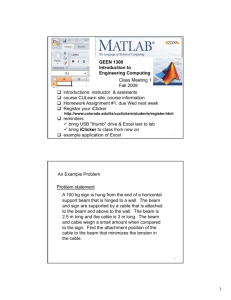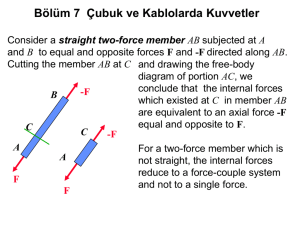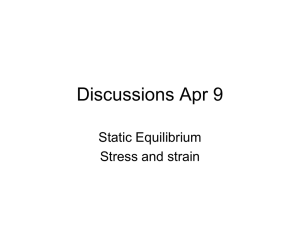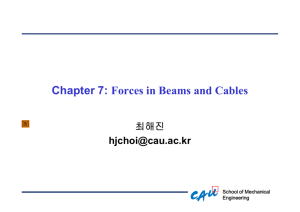Statics10
advertisement
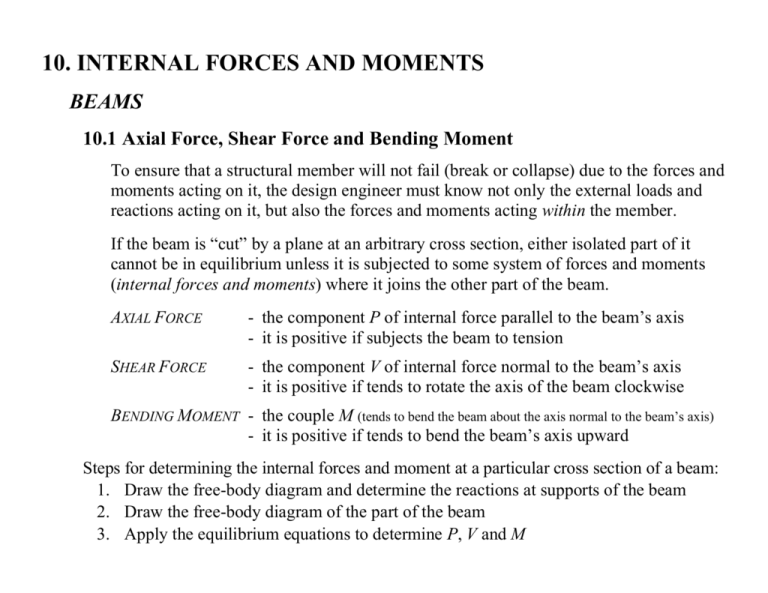
10. INTERNAL FORCES AND MOMENTS BEAMS 10.1 Axial Force, Shear Force and Bending Moment To ensure that a structural member will not fail (break or collapse) due to the forces and moments acting on it, the design engineer must know not only the external loads and reactions acting on it, but also the forces and moments acting within the member. If the beam is “cut” by a plane at an arbitrary cross section, either isolated part of it cannot be in equilibrium unless it is subjected to some system of forces and moments (internal forces and moments) where it joins the other part of the beam. AXIAL FORCE - the component P of internal force parallel to the beam’s axis - it is positive if subjects the beam to tension SHEAR FORCE - the component V of internal force normal to the beam’s axis - it is positive if tends to rotate the axis of the beam clockwise BENDING MOMENT - the couple M (tends to bend the beam about the axis normal to the beam’s axis) - it is positive if tends to bend the beam’s axis upward Steps for determining the internal forces and moment at a particular cross section of a beam: 1. Draw the free-body diagram and determine the reactions at supports of the beam 2. Draw the free-body diagram of the part of the beam 3. Apply the equilibrium equations to determine P, V and M 10.2 Shear Force and Bending Moment Diagrams To design a beam, an engineer must know the internal forces and moments throughout its length; of special concern are the maximum and minimum values and where they occur. The shear force and bending moment diagrams are simply the graphs of V and M as functions of x. 10.3 Relations Between Distributed Load, Shear Force and Bending Moment The shear force and bending moment in a beam subjected to only a distributed load w are governed by simple differential equations. dP 0 dx - axial force does not depend on x dV w dx - integrating this equation, we can determine V as a function of x dM V dx - integrating this equation, we can determine M as a function of x CABLES - often used to support loads and transmit forces in structures because of their unique combination of strength, lightness and flexibility 10.4 Loads Distributed Uniformly Along Straight Lines EXAMPLE: THE MAIN CABLE OF A SUSPENSION BRIDGE SHAPE OF THE CABLE 1 y ax 2 2 - cutting the cable at its lowest point and at an arbitrary position, drawing the free-body diagram and writing the equilibrium equations, gives where a w w – horiz. distributed load (weight of bridge), , T0 T0 – tension in the cable at its lowest point TENSION OF THE CABLE - minimum at the lowest point of the cable, increases monotonically with distance from the lowest point T T0 1 a 2 x 2 LENGTH OF THE CABLE - in the horizontal interval from 0 to x 1 1 s x 1 a 2 x 2 ln ax 1 a 2 x 2 2 a 10.5 Loads Distributed Uniformly Along Cables EXAMPLE: A CABLE’S OWN WEIGHT SHAPE OF THE CABLE y 1 ax ax 1 (e e 2) (cosh ax 1) 2a 2 TENSION OF THE CABLE 1 T T0 1 (e ax e ax ) 2 T0 cosh ax 4 LENGTH OF THE CABLE s 1 ax ax sinh ax (e e ) 2a a (catenary curve) 10.6 Discrete Loads If N known weights are suspended from a cable and the positions of the attachment points of the cable, the horizontal positions of the attachment points of the weights, and the vertical position of the attachment point of one of the weights are known, the configuration (shape) of the cable and the tension in each of its segments can be determined (by drawing a free-body diagram, cutting the cable just to the right of each of the N weights and summing the moments about each attachment point). LIQUIDS AND GASES 10.7 Pressure and the Center of Pressure The pressure (p) on a surface is defined so that the normal force exerted on an element dA of the surface, is p dA. The dimensions of pressure are (force)/(area). lb lb U.S. Customary units: 2 , 2 [psi] ft in N SI units: 2 [Pa] m Gage pressure: p g p patm (patm - atmospheric pressure) If the distributed force due to pressure on a surface is represented by an equivalent force, the point at which the line of action of the force intersects the surface is called the center of pressure. The total normal force exerted by pressure on a plane area A is F p dA A and the coordinates of the center of pressure are x p dA xp A p dA A y p dA , yp A p dA A If the pressure is uniform, the total normal force is F p A , and the center of pressure is the centroid of A. If a pressure is distributed on a plane area, the term p dA is equal to a differential element dV of the “volume” between the surface defined by the pressure distribution and the area A. The total force exerted by the pressure is equal to this “volume”, and the center of pressure coincides with the centroid of the “volume”. F dV V V x dV xp V dV V y dV yp V dV V 10.8 Pressure in a Stationary Liquid The pressure in a stationary liquid increases linearly with depth: p p0 x p0 - pressure at the surface (if open to the atmosphere, p0 patm ) - weight density of the liquid ( g ) x - depth
